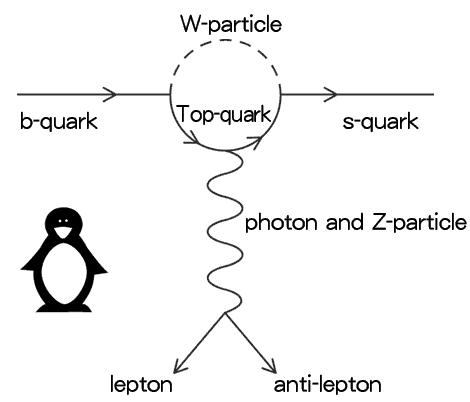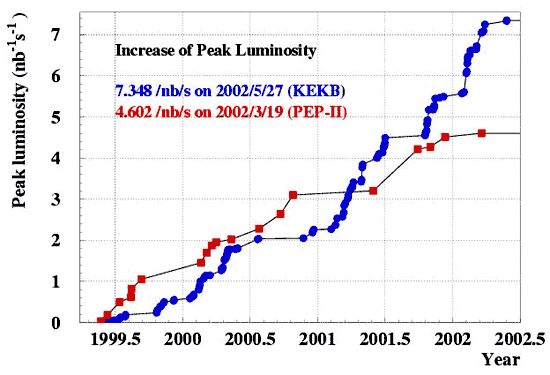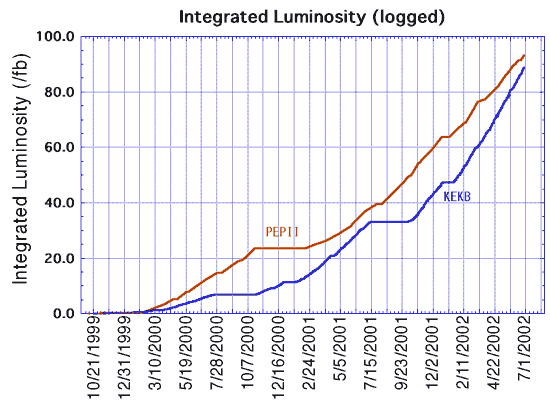
Recent Progress of the Belle Experiment
and KEKB Accelerator
[ for more details ]
July 29, 2002
High Energy Accelerator Research Organization (KEK)Since breaking the world record for accelerator performance in the spring of 2001, the KEKB accelerator has continued to produce B mesons at a rapid pace. The B meson, which on average lives for slightly more than one trillionth of a second before decaying into more stable particles, is a crucial tool used by scientists in their quest to measure tiny, but important, differences between matter and anti - matter that result from a phenomenon known as CP violation. Studies of these decays are carried out using the Belle particle detector, which is staffed by a large international collaboration of experimental particle physicists. The KEKB machine and the Belle detector are situated on the campus of the High Energy Accelerator Research Organization (KEK) in Tsukuba City, Japan. In addition to the studies of CP violation, the Belle collaboration has been searching their large data sample for evidence of unexpected particles and other new phenomena.
New phenomena: Extremely rare B meson decays
Using a sample of 31 million B meson pairs obtained last year, the Belle group made the first observation of B mesons decaying to lighter particles, known as K mesons, and lepton - antilepton pairs (leptons are a class of particles that includes electrons and a similar particle called the muon). Belle has established that this type of decay definitely exists although its occurrence is extremely rare. It is believed to occur through "quantum fluctuations" that involve the heaviest particles observed to date, namely the top (or "t") quark and the W boson. For a brief instant, the b - quark inside the B meson splits into a t - quark (35 times heavier than the b) and a W (16 times heavier than the b). The situation is akin to a person splitting into an elephant and a car for a very short time. Although such things are impossible in daily life, they can and do occur in the microscopic world of elementary particles, where quantum mechanics governs and Heisenberg's uncertainty principle holds that the laws of conservation of mass and energy can be violated for tiny durations.
Having passed through the intermediate state consisting of a W and a t - quark, the B can rematerialize as a K and a lepton anti - lepton pair. Physicists illustrate the mathematical equation for this process by the diagram shown in Fig. 1; here the top - quark and W boson appear in a "loop". By counting the number of B's that decay in this way, physicists can judge the importance of these so - called "penguin processes." These whimsically named transformations are thought to be a lightening rod for other new phenomena. A particularly interesting possibility is indirect observation of supersymmetric particles or the Higgs boson, which would make their presence felt by entering the loops.
Using twice as much data and an improved technique, the Belle experiment has now collected a total of 60 such decays, and pinned down the occurrence rate to once per 130,000 to 230,000 B meson decays. This agrees with theory, which predicts that between one in 120,000 and one in 300,000 B mesons will decay in this way. Further work is needed to improve both the accuracy of theory and experiment, but this result is an important step that could lead to new discoveries through rare decays of B mesons.CP Violation
If CP symmetry holds, all physical observables in the decays of particles should be identical to those of their anti - matter counterparts. This sort of symmetry does indeed exist for most particle - antiparticle pairs and until recently the only place where CP violation had been observed was in the decay of neutral K mesons, where the effect is quite small. However, work based on a 1974 theory of Kobayashi and Maskawa predicts the presence of significant CP violating effects (differences in the behaviour of particles and anti - particles) in the decays of neutral B mesons. The desire to test these ideas inspired physicists to pursue an ambitious two - decade program to construct devices capable of producing and detecting B's in sufficient numbers to see the predicted effects. These efforts began to come to fruition last summer, when the Belle and BaBar (a competing experiment based at the Stanford Linear Accelerator Center) experiments announced the first definitive observations of differences between the way in which the neutral B meson and neutral anti - B meson decay. (The neutral anti - B meson is the anti - particle of the neutral B meson.)
This spring, the Belle experiment was first to reveal strong indications of CP violation in another neutral B meson decay mode. Armed with a data sample that is twice as large as the one used in the initial study, the Belle team continues to analyze this new and potentially more interesting effect. They are expected to report new results soon.The KEKB Accelerator
The remarkable advances in the study of B meson decays were made possible by the superb performance of the KEKB accelerator. Its luminosity (ability to generate B mesons) surpassed that of the competing PEP - II accelerator at the Stanford Linear Accelerator Center and reached the world record for luminosity in April 2001. KEKB has held the record ever since (Fig. 2) in terms of the rate at which B mesons are produced. The PEP - II machine commenced operation somewhat earlier than KEKB, allowing the Stanford team to collect more B mesons overall. KEKB, however, has been steadily closing the gap and was within 10% in total sample size when both machines paused for summer maintenance work at the beginning of July (Fig. 3). The KEKB team hopes to surpass the PEP - II machine in sample size early this fall. The ambitious design and innovative technological developments at KEK have received worldwide recognition.
The Belle Experiment: a Large Scale International Collaboration
The Belle Collaboration consists of about 300 physicists from 50 universities and research institutions from around the world. This team, which is centered at KEK, spent over five years designing and building the Belle detector - a collection of sophisticated radiation sensors roughly the size of a small house - and since completing the detector in 1998 has been actively engaged in analyzing the large data samples it yields.
proffice@kek.jp



